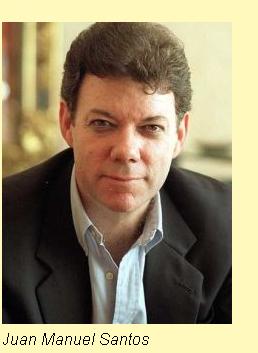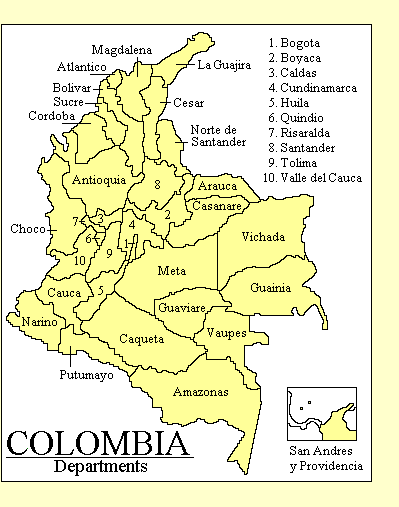
REPUBLIC OF COLOMBIA• Official name: Republica de Colombia (Republic of Colombia)
During the 19th century two political parties, the Conservatives and the Liberals, contended for power, sometimes through elections and sometimes through revolutions and counter-revolutions. There was a terrible civil war between 1899 and 1903, which left the Conservatives, representing the landlords and political centralism, in control until 1930. Colombia then adhered to democratic government under successive Liberal presidents until 1949. A disputed presidential election in 1949 led to the establishment of a right-wing dictatorship until 1953, which was followed by a series of coups until 1958, when civil government was restored and a Liberal president elected. Since then elected presidents have succeeded each other, but the country has been plagued by Communist insurgency, class conflict and, more recently, violence by right-wing extremists.  Colombia has become one of the world's major centres of narotics production, and
this has brought high levels of crime, violence and corruption. President Andres Pastrana
attempted to negotiate a settlement with the narco-terrorists of FARC, but this was
unsuccessful. In reaction, Colombians elected the Conservative
Alvaro Uribe Velez in
2002, pledged to a military solution. Uribe has largely succeeded in stamping out terrorism.
Colombia has become one of the world's major centres of narotics production, and
this has brought high levels of crime, violence and corruption. President Andres Pastrana
attempted to negotiate a settlement with the narco-terrorists of FARC, but this was
unsuccessful. In reaction, Colombians elected the Conservative
Alvaro Uribe Velez in
2002, pledged to a military solution. Uribe has largely succeeded in stamping out terrorism.
Colombian politics is still dominated by the two traditional parties, the Colombian Liberal Party (PLC), a social-democratic party, and the Colombian Conservative Party (PCC), which champions free-market economics and no negotiations with the terrorists. The Radical Change (CR) party also supports President Uribe. There are many smaller parties, mostly on the left, of which the largest is the Alternative Democratic Pole (PDA). At the 2006 elections, President Uribe was re-elected by a wide margin and the Conservatives and their allies won majorities in the Congress. At the 2010 election his chosen successor, Juan Manuel Santos Calderon, was easily elected President. Freedom House's 2011 report on Colombia says: "Colombiais an electoral democracy. The 2010 legislative elections, while less violent than previous campaigns, were marred by vote buying, opaque financing, and intimidation in some areas, particularly former paramilitary strongholds. The 2010 presidential election was relatively peaceful... Corruption occurs at multiple levels of public administration. A series of scandals involving a range of government agencies emerged late in the Uribe administration and accelerated after Santos took office... The constitution guarantees freedom of expression, and opposition viewpoints are commonly expressed. However, crime and conflict make it difficult for journalists to conduct their work... Constitutional rights regarding freedoms of assembly and association are restricted in practice by violence... All of the illegal armed groups systematically abuse human rights... The justice system remains compromised by corruption and extortion. The Constitutional Court and Supreme Court have, on multiple occasions, demonstrated independence from the executive. Lower courts are more susceptible to political and criminal influence." Updated November 2011 |
